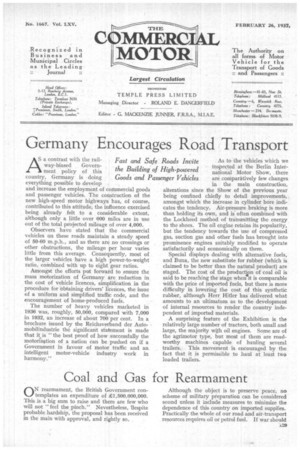Germany Encourages Road Transport
Page 31

If you've noticed an error in this article please click here to report it so we can fix it.
ASa contrast with the railway-biased Govern ment policy of this country, Germany is doing everything possible to develop and increase the employment of commercial goods and passenger vehicles. The construction of the new high-speed motor highways has, of course, contributed to this attitude, the influence exercised being already felt to a considerable extent, although only a little over 600 miles are in use out of the total projected mileage of over 4,000.
Observers have stated that the commercial vehicles on these roads maintain a steady speed of 50-60 m.p.h., and as there are no crossings or other obstructions, the mileage per hour varies little from this average. Consequently, most of the larger vehicles have a high power-to-weight ratio, combined with up to eight gear ratios.
Amongst the efforts put forward to ensure the mass motorization of Germany are reduction in the cost of vehicle licences, simplification in the procedure for obtaining drivers' licences, the issue of a uniform and simplified traffic code, and the encouragement of home-produced fuels.
The number of heavy vehicles marketed in 1936 was, roughly, 50,000, compared with 7,000 in 1932, an increase of about 700 per cent In a brochure issued by the Reichsverband der Autornobilindustrie the significant statement is made that it is "the best proof of how successfully the motorlziation of a nation can be pushed on if a Government in favour of motor traffic and an intelligent motor-vehicle industry work in harmony." As to the vehicles which we inspected at the Berlin International Motor Show, there are comparatively few changes in the main construction, alterations since the Show of the previous year being confined chiefly to detail improvements, amongst which the increase in cylinder bore indicates the tendency. Air-pressure braking is more than holding its own, and is often combined with the Lockheed method of transmitting the energy to the shoes. The oil engine retains its popularity, but the tendency towards the use of compressed gas, suction gas and other fuels has brought into prominence engines suitably modified to operate satisfactorily and economically on them.
Special displays dealing with alternative fuels, and Buna, the new substitute for rubber (which is claimed to be better than the natural product) are staged. The cost of the production of coal oil is said to be reaching the stage when it is comparable with the price of imported fuels, but there is more difficulty in lowering the cost of this synthetic rubber, although Herr Hitler has delivered what amounts to an ultimatum as to the development of internal resources to render the country independent of imported materials.
A surprising feature of the Exhibition is the relatively large number of tractors, both small and large, the majority with oil engines. Some are of the agrimotor type, but most of them are roadworthy machines capable of hauling several trailers. This movement is encouraged by the fact that it is permissible to haul at least two loaded trailers.




























































































